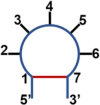Identification and characterization of RNA pentaloop sequence families
- PMID: 36632613
- PMCID: PMC9830547
- DOI: 10.1093/nargab/lqac102
Identification and characterization of RNA pentaloop sequence families
Abstract
One of the current methods for predicting RNA tertiary structure is fragment-based homology, which predicts tertiary structure from secondary structure. For a successful prediction, this method requires a library of the tertiary structures of small motifs clipped from previously solved RNA 3D structures. Because of the limited number of available tertiary structures, it is not practical to find structures for all sequences of all motifs. Identifying sequence families for motifs can fill the gaps because all sequences within a family are expected to have similar structural features. Currently, a collection of well-characterized sequence families has been identified for tetraloops. Because of their prevalence and biological functions, pentaloop structures should also be well-characterized. In this study, 10 pentaloop sequence families are identified. For each family, the common and distinguishing structural features are highlighted. These sequence families can be used to predict the tertiary structure of pentaloop sequences for which a solved structure is not available.
© The Author(s) 2023. Published by Oxford University Press on behalf of NAR Genomics and Bioinformatics.
Figures



Similar articles
-
Identification and Characterization of New RNA Tetraloop Sequence Families.Biochemistry. 2019 Dec 3;58(48):4809-4820. doi: 10.1021/acs.biochem.9b00535. Epub 2019 Nov 12. Biochemistry. 2019. PMID: 31714066 Free PMC article.
-
Thermodynamic characterization of naturally occurring RNA pentaloops.RNA. 2022 Jun;28(6):832-841. doi: 10.1261/rna.078915.121. Epub 2022 Mar 22. RNA. 2022. PMID: 35318243 Free PMC article.
-
Identification of a GUAAY Pentaloop Sequence Involved in a Novel RNA Loop-Helix Interaction.J Mol Biol. 2016 Dec 4;428(24 Pt B):4882-4889. doi: 10.1016/j.jmb.2016.10.015. Epub 2016 Oct 19. J Mol Biol. 2016. PMID: 27771480 Free PMC article.
-
Protein structure prediction: recognition of primary, secondary, and tertiary structural features from amino acid sequence.Crit Rev Biochem Mol Biol. 1995;30(1):1-94. doi: 10.3109/10409239509085139. Crit Rev Biochem Mol Biol. 1995. PMID: 7587278 Review.
-
RNA structural motifs: building blocks of a modular biomolecule.Q Rev Biophys. 2005 Aug;38(3):221-43. doi: 10.1017/S0033583506004215. Epub 2006 Jul 3. Q Rev Biophys. 2005. PMID: 16817983 Review.
References
-
- Prasanth K.V., Prasanth S.G., Xuan Z., Hearn S., Freier S.M., Bennett C.F., Zhang M.Q., Spector D.L.. Regulating gene expression through RNA nuclear retention. Cell. 2005; 123:249–263. - PubMed
-
- Strulson C.A., Molden R.C., Keating C.D., Bevilacqua P.C.. RNA catalysis through compartmentalization. Nat. Chem. 2012; 4:941–946. - PubMed
-
- Noller H.F., Hoffarth V., Zimniak L.. Unusual resistance of peptidyl transferase to protein extraction procedures. Science. 1992; 256:1416–1419. - PubMed
Grants and funding
LinkOut - more resources
Full Text Sources

